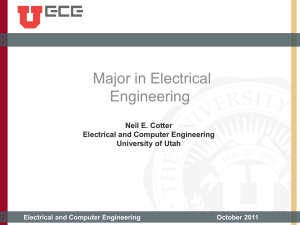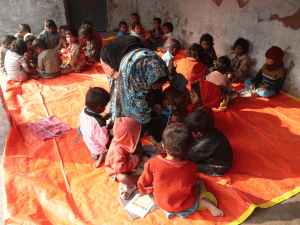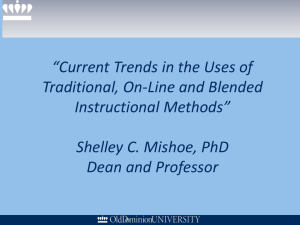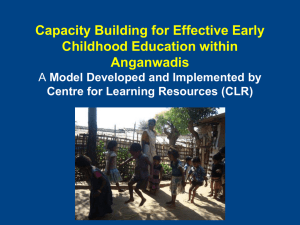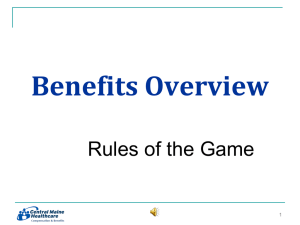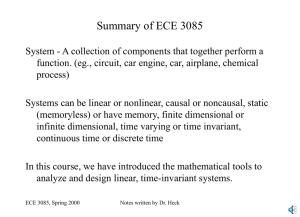“cost” of care - Alliance for Early Success
advertisement
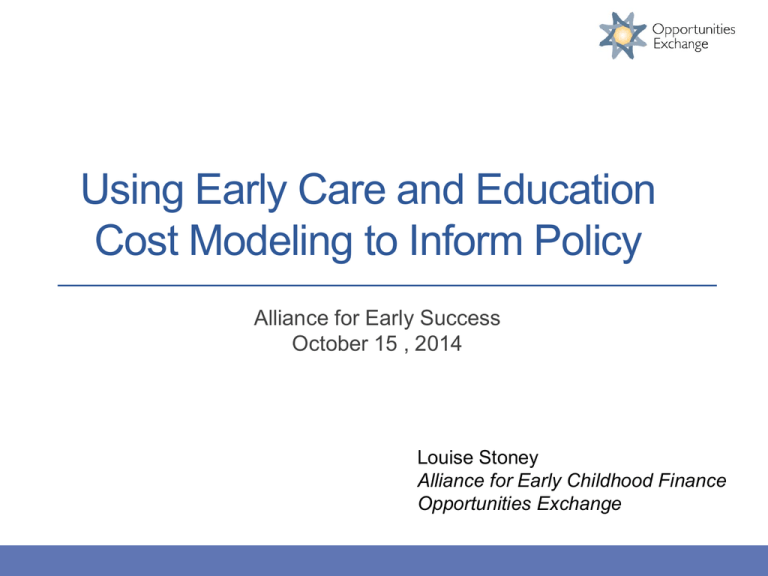
Using Early Care and Education Cost Modeling to Inform Policy Alliance for Early Success October 15 , 2014 Louise Stoney Alliance for Early Childhood Finance Opportunities Exchange What is Cost Modeling? • A tool to estimate (model) the likely cost of providing early care and education services at varying levels of quality • Excel spreadsheets or online tools • Models a ‘reasonable’ budget given standards; does not reflect the actual budget of any specific center • Design of the model depends on what you’re trying to measure or learn about, for example: • Cost for a service provider to deliver ECE at various QRIS levels • Cost for a Shared Service Alliance (provider network) to deliver ECE • Cost for a state to provide subsidies or QRIS incentives under various scenarios; can also develop model for infrastructure costs if desired • How various revenue sources (HS/EHS, Prek, etc) impact cost • Implications of the Iron Triangle (full enrollment & fee collection, rates) ECE Cost Model Page 2 Online Cost Models for ECE • PCQC (“Provider Cost of Quality Calculator”) • Web-based platform based on spreadsheets developed by Anne Mitchell (today’s example based on same spreadsheets) • Designed to helps states and providers understand costs at different levels of quality, and degree of gap between revenues and costs • To be launched October 2014: www.ECEQualityCalculator.com • CEM (“Cost Estimation Module”) • Online tool designed to help state administrators determine costs of implementing all elements of a QRIS and explore phase-in and scaleup options • Can be used to estimate the cost per year of phasing in a QRIS, the cost of certain elements, or the overall cost of a full implemented QRIS. • Available on ACF website: http://www.acf.hhs.gov/programs/occ/resource/qris-cost-estimationmodel-and-resource-guide ECE Cost Model Page 3 Using Cost Modeling to Inform Policy • Several States have used the cost modeling spreadsheets to understand the financial picture of center-based child care. • Developed with information from local providers and ECE organizations in the particular state • Informed by cost modeling spreadsheets developed by Anne Mitchell • Can apply revenues from multiple sources (HS/EHS, PreK, CCDF, etc) • Model enables advocates to make the case with data and sophisticated fiscal analysis • Model can also provides some guidance about how to address this challenge ECE Cost Model Page 4 Understanding a Provider’s Bottom Line Center-focused cost modeling can help answer: • Given reasonable assumptions, can a center at least break even? • What is the impact on the bottom line of moving up the quality ladder? • What are the factors that have a positive, or negative, effect on the bottom line? • Revenues • Expenses • Operating Model (staffing, age mix, family income mix, etc.) • Business practices ECE Cost Model Page 5 How the Model Can be Used • Enables exploration of how various factors can affect profit or loss, e.g.: • Increased scale • Income mix of families served • Enrollment levels • Fee collectability • Subsidy policy changes • Revenue sources, e.g. state-funded PreK or QRIS • Enables modeling budget for a proposed center or group of centers ECE Cost Model Page 6 Policy Implications: Modeling the Iron Triangle • Ensure full enrollment – every day, in every classroom • Collect tuition and fees – in full and on-time • Revenue covers per-child cost (tuition, fees + 3rd party funding) State Example: Modeling the Impact of the Iron Triangle $100,000 $50,000 $0 Regulated Star 2 Star 3 Star 4 Star 5 ($50,000) ($100,000) ($150,000) ($200,000) Basic Approach "Iron Triangle" Approach Iron Triangle approach boosts enrollment to 95% & lowers bad debt to 2% State Example: Impact of Enrollment on Cost-per-child Annual Cost Per Child All ages, Star 4 Center in Louisiana Capacity = 76 $11,001 $9,378 $8,688 75% 88% Enrollment as % of Capacity 95% State Example: Per Child Cost by Age and Enrollment $11,553 Per-Child Costs $10,315 $9,731 $8,688 80% Enrollment $8,287 95% Enrollment $6,981 Centers Serving Only Infants/Toddlers Centers Serving Only 3's and Centers Serving All Ages (0-4) 4's State Example: Impact of Increasing Enrollment on Revenue Needed for Higher Stars $80,000 $60,000 $40,000 $20,000 Star 1 Star 2 $0 Star 3 ($20,000) Star 4 ($40,000) ($60,000) ($80,000) 83% 85% 87% 89% 91% 93% 95% % Enrollment as percentage of Center Staffed Capacity 97% State Example: Co-Payments Based on Cost of Care Family of 4, parents earn minimum wage, annual income $30,160 (New Orleans, LA) Weekly Rates Private Tuition Child care subsidy rate ceiling CCAP reimbursement after co-pay co-pay for this family = 60% of “cost” of care (e.g. of the state rate ceiling) Total cost to parent Parent cost as % of weekly income Infant $150 $92.50 $37.00 3-year-old $135 $87.50 $35.00 Total $285 $180.00 $72.00 $113.00 19.5% $100. 17.2% $213.00 36.7% State Example: Co-Payments Based on Family Income Family of 4, parents earn minimum wage, annual income $30,160 (Charlotte, NC ) Weekly Rates Private Tuition Child care subsidy rate ceiling CCAP reimbursement after co-pay co-pay = 11% of income; $32 wk per child Total cost to parent* Parent cost as % of weekly income Parent cost if provider charges differential Infant 3-year-old $200 $175 $185 $168 $153 $136 Total $375 $353 $289 $32 $32 $64 5.5% 5.5% 11% $47 (8%) $39 (6.7)% $86 (14.8%) *Note: 24% of NC centers elect to collect additional fee to cover difference between subsidy ceiling & private rate; in this case parent fee would be higher Potential Challenges • ECE cost modeling typically demonstrates that a high- quality, market-based program with less than 100 children can rarely break even. • But most ECE programs in the US are this small….so how can we explain that more programs haven’t closed? • ECE cost modeling often reveals that programs at base level of QRIS (e.g. Star 1 or 2) that are fully enrolled do not need higher rates; the largest inequity is with programs that meet higher star levels. • This can be a challenging finding from an advocacy perspective • Can inform rate-setting for programs that tap multiple funding streams • IF funders are willing to collaborate on accountability/monitoring ECE Cost Model Page 14 For more information… Louise Stoney Consultant to the Alliance for Early Success louise.stoney@gmail.com Alliance for Early Childhood Finance http://www.earlychildhoodfinance.org/ Opportunities Exchange www.opportunities-exchange.org ECE Cost Model Page 15



